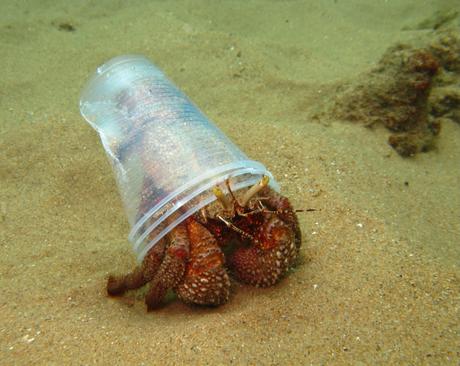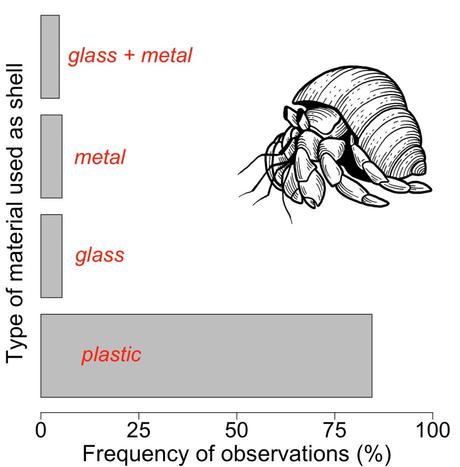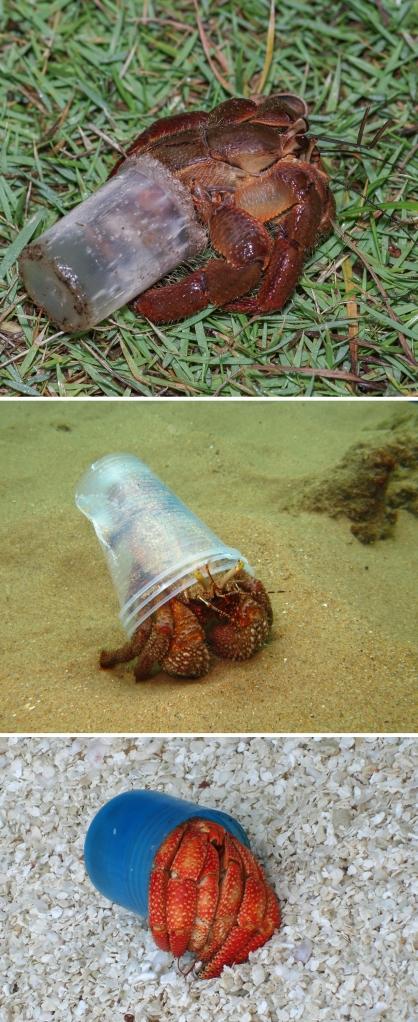The internet has become an informational telescope to study what happens nearly everywhere the planet. Using internet observations, it has been recently documented that terrestrial hermit crabs use plastic waste as shelter along tropical coasts.
Before the internet irrupted, I was living in Spain and frequently travelled from my hometown to universities in Valencia and Barcelona to access scientific journals. Back then, these journals were only available in print or on compact discs. Today, I can do the same thing from home with an internet connection.

The emergence of public internet since the 1990s has globalised information and represents a data source for many areas of science (1, 2). When applied to nature, the term iEcology (internet Ecology) refers to the use of online documentation to study the natural history of plants and animals, their distributions, and the effects of humans on them (3). In fact, the internet highlights and promotes certain research topics. For example, bird species that are more frequently mentioned on social networks tend to be described taxonomically earlier, and are also the ones that interact most (positively or negatively) with human activity (4).
In search of the phenomenon
By exploring internet platforms Alamy, Flickr, Google, YouTube, and iNaturalist, Zuzanna Jagiello and her collaborators collected nearly 30 thousand photographs of hermit crabs to study the use of rubbish by these crustaceans (5). Hermit crabs are known for their peculiar habit of using empty snail shells to house their unprotected abdomens, carrying them around like someone traveling with their house on their back (6) — David Attenborough narrates here a funny swapping of shells among crabs of different size. The researchers aimed to assess the extent of the phenomenon of hermit crabs replacing natural shells with artificial materials as mobile homes (see video capturing the scene).

The family Coenobitidae, distributed throughout tropical regions, includes hermit crabs whose adults live on land. It comprises 17 species in the genus Coenobita and 1 species in the genus Birgus: the coconut crab Birgus latro), the largest known terrestrial arthropod, reaching up to 1 m in length and weighing up to 4 kg (7). Reproduction among Coenobita species occurs on land, where females walk to the sea to lay their eggs. The larvae float in the water as part of the plankton, and the final larval stage (called “megalopa” due to its large eyes) colonizes rocky beaches. There, it buries itself in the sand to undergo the miracle of metamorphosis, transforming into an adult that will choose its first shell — like a gala outfit for returning to the terrestrial ecosystem of its parents.
They focused on terrestrial species (genus Coenobita), which are distributed along the tropical coasts of the Atlantic, Indian, and Pacific Oceans. In total, Jagiello et al. found 386 images of crabs that had chosen artificial shelters. About 85% of the observations involved plastic objects, while the remaining 15% were divided among metal, glass, or combinations of both such as the base of a broken lightbulb. The sample represented 10 species out of the 17 known Coenobita species (7), spanning the three ocean basins.
Using the internet as a planetary observatory was justified in this case because Jagiello et al. (5) found only four examples of hermit crab-plastic interactions in scientific publications, which documented cases in the Maldives, and along the coasts of Belize, Brazil, and the Philippines (8-11).
Benefit of the artificial
Plastic pollution is a global threat to biodiversity, largely because many of its impacts are irreversible (12). Each species is affected in a particular way, depending on its lifestyle and habitat (13). In crustaceans, the primary effects are physiological — when animals ingest or breathe in fragments of this material — and across ecosystems — when the problem transfers between species along the food chain (14).

Top: Forest hermit crab Coenobita spinosus inside a film reel canister on the island of Guam (USA, Pacific), near the houses on Trankilidat Street, where large amounts of solid waste are dumped into the sea (10).
Middle: Giant hermit crab Petrochirus diogenes housed in a stack of three drink cups typically used in bars near the rocky marine area of the Barra district, Salvador de Bahia (Brazil, Atlantic) (9).
Bottom: A hermit crab sheltered in half of a surprise toy container, the kind sold inside chocolate eggs, found on atolls near Kooddoo (Maldives, Indian) (8).
The mobile home of hermit crabs is a critical factor for their survival and reproductive success, determined by their decision to choose a shell from a limited number of suitable options. This is why hermit crabs are often used as models for studying animal behavior in response to stressful conditions like pollution (24).
Whether natural or artificial, the shell allows them to store water—without it, they die from desiccation. Unlike marine species, terrestrial hermit crabs use their claws to expand the interior space of the shell to store more eggs (females) or accommodate larger bodies (males).
Interestingly, males of species that remodel their shells more extensively tend to have longer penises (25). Since they must expose their abdomens by leaving their shells during reproduction (risking having their shells stolen by other individuals), this remarkable adaptation allows males to minimize the distance between their abdomen and their shell during mating. The longer their penises, the more they can maximize the distance from the females while maintaining reproductive success.
Photos courtesy of Makoto Sasazuka (Guam), Gustavo Freire de Carvalho Souza (Barra), and João Pedro da Silva Ramos(Kooddoo).
Each year the equivalent of 2,000 Eiffel Towers’ weight (about 20 million tonnes) of plastic waste enters the sea, dispersing everywhere (15). There is already talk of a “plastisphere” as a community of microorganisms living on plastic (16, 17) [see video summary]. However, this concept can extend functionally to any species capable of using this synthetic compound that we only invented in the early 20th Century.
How does taking shelter in a plastic burrow benefit a hermit crab compared to using a snail shell? Several mechanisms might explain (5). On the one hand, there has been a widespread decline in mollusc abundance and diversity since the 16th Century due to human exploitation and climate change (18, 19). As a result, in some regions, hermit crabs might have more artificial than natural shells available for housing. So much so that due to the increasing use of artificial materials by these animals and the scarcity of empty natural shells compared to the number of crabs, authorities at Mu Ko Surin National Park in Thailand have organised campaigns to donate natural snail shells. These campaigns encourage people who have shells in their collections or from other sources to contribute them, then the shells are dispersed across the habitat of hermit crabs for their use as homes.
It is also possible that the unusual appearance of a plastic shell makes it unattractive or a deterrent to predators, reducing the mortality of these crabs — analogous to how predators and prey might not recognize each other when one is an invader from a different biogeographical region (20). Additionally, it cannot be ruled out that an individual might prefer a crab mate with an innovative appearance, where a gorgeous detergent bottle cap guarantees mating success, akin to birds choosing partners with the most spectacular plumage.
Finally, terrestrial hermit crabs select smaller mollusc shells from those available in their habitat because carrying (literally, dragging) a lighter home requires less energy for movement (21) For this reason, these crabs might prefer a synthetic polymer home, which at the same size, should be lighter than a natural calcium-carbonate shell. In contrast, hermit crabs living in the ocean will take other factors into consideration for the selection of shells as homes (22); for instance, they might prefer larger and heavier shells where seabed currents are strong (23).
Clearly, as harmful as plastic is to biodiversity, once it enters the environment, many living beings will perceive it as a potential resource and will try to exploit it with varying degrees of success.
References
- Kouzes RT, Myers JD, Wulf WA. 1996. Collaboratories: doing science on the internet. Computer 29: 40-46
- Rzepa HS. 1996. Science and the internet: the world-wide web. Science Progress 79: 97-117
- Jarić I et al. 2020. iEcology: harnessing large online resources to generate ecological insights. Trends in Ecology & Evolution 35: 630-639
- Ladle RJ et al. 2019. A culturomics approach to quantifying the salience of species on the global internet. People and Nature 1: 524-532
- Jagiello Z, Dylewski Ł, Szulkin M. 2024. The plastic homes of hermit crabs in the Anthropocene. Science of The Total Environment 913: 168959
- Elwood RW. 2022. Hermit crabs, shells, and sentience. Animal Cognition 25: 1241-1257
- Fornshell JA. 2024. The morphology and potential function of mechanoreceptors found on members of the family Coenobitidae. Arthropods 13: 7-14
- Barreiros JP, Luiz OJ. 2009. Use of plastic debris as shelter by an unidentified species of hermit crab from the Maldives. Marine Biodiversity Records 2: e33
- de Carvalho-Souza GF et al. 2018. Marine litter disrupts ecological processes in reef systems. Marine Pollution Bulletin 133: 464-471
- Sasazuka M, Hamasaki K, Dan S. 2019. Shell utilization and shell-shedding behavior by the land hermit crab Coenobita spinosus. Ethology Ecology & Evolution 31: 544-556
- Sharma K. 2018. Hazardous hermit crab homes. Frontiers in Ecology and the Environment 16: 287-287
- MacLeod M et al. 2021. The global threat from plastic pollution. Science 373: 61-65
- Thushari GGN, Senevirathna JDM. 2020. Plastic pollution in the marine environment. Heliyon 6: e04709
- Pisani XG et al. 2022. Plastics in scene: a review of the effect of plastics in aquatic crustaceans. Environmental Research 212: 113484
- Tekman MB et al. 2022. Impacts of plastic pollution in the oceans on marine species, biodiversity and ecosystems. World Wildlife Fund (Germany)
- Amaral-Zettler LA, Zettler ER, Mincer TJ. 2020. Ecology of the Plastisphere. Nature Reviews Microbiology 18: 139-151
- Wright RJ, Langille MGI, Walker TR. 2021. Food or just a free ride? A meta-analysis reveals the global diversity of the Plastisphere. The ISME Journal 15: 789-806
- Gazeau F et al. 2013. Impacts of ocean acidification on marine shelled molluscs. Marine Biology 160: 2207-2245
- Régnier C et al. 2017. Measuring the Sixth Extinction: what do mollusks tell us? The Nautilus: 1-54
- Carthey AJR, Banks PB. 2014. Naïveté in novel ecological interactions: lessons from theory and experimental evidence. Biological Reviews 89: 932-949
- Contreras-Garduño J, Osorno JL, Macías-Garcia C. 2009. Weight difference threshold during shell selection relates to growth rate in the semi-terrestrial hermit crab Coenobita compressus. Behaviour 146: 1601-1614
- Hazlett BA. 1981. The behavioral ecology of hermit crabs. Annual Review of Ecology, Evolution, and Systematics 12: 1-22
- Alcaraz G, Toledo B, Burciaga LM. 2020. The energetic costs of living in the surf and impacts on zonation of shells occupied by hermit crabs. Journal of Experimental Biology 223: jeb222703
- Briffa M, Arnott G, Hardege JD. 2024. Hermit crabs as model species for investigating the behavioural responses to pollution. Science of the Total Environment 906: 167360
- Laidre ME. 2019. Private parts for private property: evolution of penis size with more valuable, easily stolen shells. Royal Society Open Science 6: 181760

